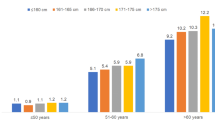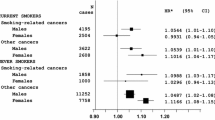Abstract
Objectives: The purpose of the study was to describe the associations between height and body mass index (BMI) (wt/ht2) and breast cancer incidence and survival among female residents of Hawaii. Methods: The study sample is a randomly-selected, multi-ethnic cohort of 17,628 women. A total of 378 incident breast cancer cases were identified via linkage to the Hawaii Tumor Registry over an average follow-up period of 14.9 years. Using age 50 as a cut-point, 86 were considered premenopausal cases, and 292 were postmenopausal. Proportional hazards analysis was used to describe the risks associated with height and BMI, after adjustment for age, education, race/ ethnicity, and drinking status. For mortality analyses, there were 34 breast cancer deaths among the 365 breast cancer cases for which staging information was available. Results: The risk of postmenopausal breast cancer was found to increase progressively across approximate tertiles of the distribution of height (P = 0.02 for trend test), with a significantly excess risk among women in the tallest tertile (risk ratio [RR] = 1.5, 95 percent confidence interval [CI] = 1.1-2.1). Baseline levels of BMI were related positively to breast cancer incidence among postmenopausal women, after control for the above covariates (P = 0.01 for trend test). Among postmenopausal women in the highest quintile of the BMI distribution, the RR was 1.5 (CI = 1.0-2.3, P = 0.04). Further analyses indicated the association between BMI and postmenopausal breast cancer incidence was strongest among women aged 65 years and older. After statistical control for the above covariates and stage of disease, pre-morbid levels of BMI were significantly predictive of death from breast cancer, with an approximate nine percent increase in risk per unit increase in BMI (P = 0.01). Compared with women in the lowest two quartiles, the RR among the heaviest women was 2.2 (CI = 0.9-5.4, P = 0.08). Height was not associated with risk of breast cancer mortality. Conclusions: Relative weight may be an important modifiable risk factor for both breast cancer incidence and prognosis. The association between height and breast cancer incidence is more difficult to interpret, but may underscore the importance of early life exposures in the development of breast cancer.
Similar content being viewed by others
References
DeWaard F, Trichopoulos D. A unifying concept of the aetiology of breast cancer. Int J Cancer 1988; 41: 666–9.
Hunter DJ, Willett WC. Diet, body size, and breast cancer. Epidemiol Rev 1993; 15: 110–32.
Ballard-Barbash R. Anthropometry and breast cancer. Cancer 1994; 74: 1090–100.
LeMarchand L. Anthropometry, body composition, and cancer. In: Micozzi MS, Moon TE, eds. Macronutrients: Investigating their Role in Cancer. New York, NY (USA): Marcel Dekker Inc., 1992: 321–31.
Stoll BA. Timing of weight gain in relation to breast cancer risk. Ann Oncology 1995; 6: 245–8.
Moolgavkar SH, Day NE, Stevens RG. Two-stage model for carcinogenesis: epidemiology of breast cancer in females. J Natl Cancer Inst 1980; 65: 559–69.
Siiteri PK. Adipose tissue as a source of hormones. Am J Clin Nutr 1987; 45: 277–82.
Hershcopf RJ, Bradlow HL. Obesity, diet, endogenous estrogens, and the risk of hormone-sensitive cancer. Am J Clin Nutr 1987; 45: 283–9.
Enriori CL, Reforzo-Membrives J. Periperal aromatization as a risk factor for breast and endometrial cancer in postmenopausal women: a review. Byn Oncol 1984; 17: 1–21.
Swanson CA, Brinton LA, Taylor PR, et al. Body size and breast cancer risk assessed in women participating in the Breast Cancer Detection Demonstration Project. Am J Epidemiol 1989; 130: 1133–41.
Ziegler RG, Hoover RN, Nomura AMY, et al. Relative weight, weight change, height, and breast cancer risk in Asian-American women. J Natl Cancer Inst 1996; 88: 650–60.
Swanson, CA, Coates RJ, Schoenberg JB, et al. Body size and breast cancer risk among women under age 45 years. Am J Epidemiol 1996; 143: 698–706.
Swanson CA, Jones DY, Schatzkin A, Brinton LA, Ziegler RG. Breast cancer risk assessed by anthropometry in the NHANES I Epidemiological Follow-up Study. Cancer Res 1988; 48: 5363–7.
Tornberg SA, Holm LE, Carstensen JM. Breast cancer risk in relation to serum cholesterol, serum beta-lipoprotein, height, weight, and blood pressure. Acta Oncol 1988; 27: 31–7.
Tretli S. Height and weight in relation to breast cancer morbidity and mortality. A prospective study of 570,000 women in Norway. Int J Cancer 1989; 44: 23–30.
Vatten LJ, Kvinnsland S. Prospective study of height, body mass index and risk of breast cancer. Acta Oncol 1992; 31: 195–200.
DeStavola BL, Wang DY, Allen DS, et al. The association of height, weight, menstrual and reproductive events with breast cancer: results from two prospective studies on the island of Guernsey(United Kingdom). Cancer Causes Control 1993; 4: 331–40.
Freni SC, Eberhardt MS, Turturro A, Hine RJ. Anthropometric measures and metabolic rate in association with risk of breast cancer (United States). Cancer Causes Control 1996; 7: 358–65.
Hislop TG, Coldman AJ, Elwood JM, et al. Childhood and recent eating patterns and risk of breast cancer. Cancer Detect Prev 1986; 9: 47–58.
Ewertz M. Influence of non-contraceptive exogenous and endogenous sex hormones on breast cancer risk in Denmark. Int J Cancer 1988; 42: 832–8.
London SJ, Colditz GA, Stampfer MJ, Willett WC, Rosner BA, Speizer FE. Prospective study of relative weight, height, and risk of breast cancer. JAMA 1989; 262: 2853–8.
der Tonkelaar, Seidell JC, Collette HJA, et al. A prospective study on obesity and subcutaneous fat patterning in relation to breast cancer in post-menopausal women participating in theDOMproject. Br J Cancer 1994; 69: 352–7.
Le Marchand L, Kolonel LN, Earle ME, Mi MP. Body size at different periods of life and breast cancer risk. Am J Epidemiol 1988; 128: 137–52.
Paffenbarger RS, Kampert JB, Chang HG. Characteristics that predict risk of breast cancer before and after the menopause. Am J Epidemiol 1980; 112: 258–68.
Hsieh C-c, Trichopolous D, Katsouyanni K, et al. Age at menarche, age at menopause, height and obesity as risk factors for breast cancer: associations and interactions in an international case-control study. Int J Cancer 1990; 46: 796–800.
Chu SY, Lee NC, Wingo PA, et al. The relationship between body mass index and breast cancer among women enrolled in the Cancer and Steroid Hormone Study. J Clin Epidemiol 1991; 44: 1197–206.
Yong LC, Brown CC, Schatzkin A, Schairer C. Prospective study of relative weight and risk of breast cancer: the Breast Cancer DetectionDemonstration Project Follow-up Study, 1979 to 1987-89. Am J Epidemiol 1996; 143: 985–95.
Folsom AR, Kaye SA, Prineas RJ, et al. Increased incidence of carcinoma of the breast associated with abdominal adi-posity in postmenpausal women. Am J Epidemiol 1990; 131: 794–803.
Ballard-Barbash R, Schatzkin A, Carter CL, et al. Body fat distribution and breast cancer in the Framingham Study. J Natl Cancer Inst 1990; 82: 286–90.
Harris JR, Lippman ME, Veronesi U, Willett WC. Breast cancer. N Engl J Med 1992; 327: 19–28.
Gordon NH, Crowe JP, Brumberg DJ, Berger NA. Socioeconomic factors and race in breast cancer recurrence and survival. Am J Epidemiol 1992; 135: 609–18.
Obermair A, Kurz C, Hanzal E, et al. The influence of obesity on the disease-free survival in primary breast cancer. Anticancer Res 1995; 15: 2265–70.
Gregorio DI, Emrich LJ, Graham S, Marshall JR, Nemoto T. Dietary fat consumption and survival among women with breast cancer. J Natl Cancer Inst 1985; 75: 37–41.
Vatten LJ, Foss OP, Kvinnsland S. Overall survival of breast cancer patients in relation to preclinically determined total serum cholesterol, body mass index, height and cigarette smoking: a population-based study. Eur J Cancer 1991; 27: 641–6.
Tretli S, Haldorsen T, Ottestad L. The effect of pre-morbid height and weight on the survival of breast cancer patients. Br J Cancer 1990; 62: 299–303.
Coates RJ, Clark WS, Eley JW, etal. Race, nutritional status, and survival from breast cancer. J Natl Cancer Inst 1990; 82: 1684–92.
Jain M, Miller AB. Pre-morbid body size and the prognosis of women with breast cancer. Int J Cancer 1994; 59: 363–8.
Zhang S, Folsom AR, Sellers TA, Kushi LH, Potter JD. Better breast cancer survival for postmenopausal women who are less overweight and eat less fat. The Iowa Women's Health Study. Cancer 1995; 76: 275–83.
Oyama N, Johnson DB. Hawaii Health Surveillance Program: Survey Methods and Procedures. Honolulu, Hawaii (USA): Research and Statistics Office, Hawaii State Department of Health, 1986; R&S Rep. 54.
Mi MP, Kagawa JT, Earle ME. An operational approach to record linkage. Methods Inf Med 1983; 22: 77–82.
Cox DR. Regression models and life tables (with discussion). JR Stat Soc [B] 1972; 34: 187–220.
Morabia A, Flandre P. Misclassification bias related to definition of menopausal status in case-control studies of breast cancer. Int J Epidemiol 1992; 21: 222–8.
SAS Institute, Inc. SAS User's Guide. Cary, NC (USA): SAS Institute, Inc., 1990.
Stunkard AJ, Albaum JM. The accuracy of self-reported weights. Am J Clin Nutr 1981; 34: 1593–9.
Rowland ML. Self-reported weight and height. Am J Clin Nutr 1990; 52: 1125–33.
Nieto-Garcia FJ, Bush TL, Keyl PM. Body mass definitions of obesity: sensitivity and specificity using self-reported weight and height. Epidemiology 1990; 1: 146–52.
Stoll BA. Breast cancer: the obesity connection. Br J Cancer 1994; 69: 799–801.
Welsch CW. Enhancement of mammary tumorigenesis by dietary fat: review of potential mechanisms. Am J Clin Nutr 1987; 45: 192–202.
Hemsell DL, Grodin JM, Brenner PF, Siiteri PK, MacDonald PC. Plasma precursors of estrogen. II. Correlation of the extent of conversion of plasma androstenedione toestrone with age. J Clin Endocrinol Metab 1974; 38: 476–9.
Simpson ER, Mendelson CR. Effect of aging and obesity on aromatase activity of human adipose cells. Am J Clin Nutr 1987; 45: 290–5.
Meldrum DR, Davidson BJ, Tataryn IV, Judd HL. Changes in circulating steroids with aging in postmenopausal women. Obstet Gynecol 1981; 57: 624–8.
Judd HL, Davidson BJ, Frumar AM, Shamonki IM, Lagasse LD, Ballon SC. Serum androgens and estrogens in postmenopausal women with and without endometrial cancer. Am J Obstet Gynecol 1980; 136: 859–71.
NationalInstitutes of Health Consensus Development Conference Statement. Health implications of obesity. Ann Intern Med 1993; 103: 1073–7.
Author information
Authors and Affiliations
Rights and permissions
About this article
Cite this article
Galanis, D.J., Kolonel, L.N., Lee, J. et al. Anthropometric predictors of breast cancer incidence and survival in a multi-ethnic cohort of female residents of Hawaii, United States. Cancer Causes Control 9, 217–224 (1998). https://doi.org/10.1023/A:1008842613331
Issue Date:
DOI: https://doi.org/10.1023/A:1008842613331




